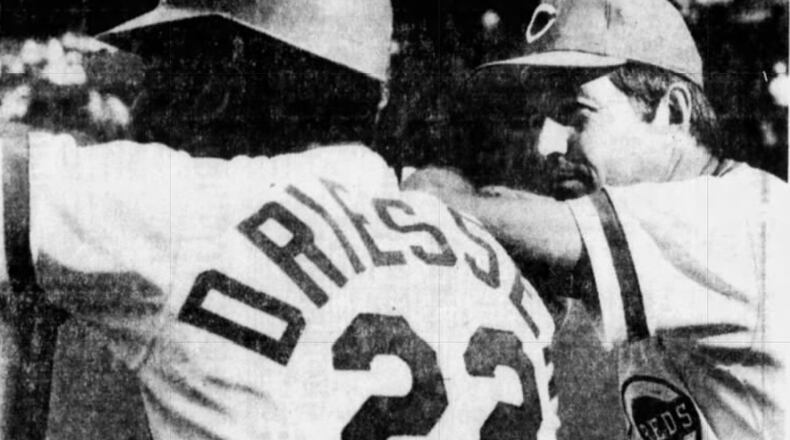Only one Reds team has lost 100 games, and the 40th anniversary of that 100th loss passed Sunday on the same day the 2022 team lost its 99th game: 8-1 to the Chicago Cubs at Wrigley Field.
Here’s a look back at the 1982 Reds and the day they hit the century mark:
Setting the scene: The Reds finished 66-42 in the strike-shortened 1981 season but didn’t make the playoffs because the season was split into two halves, and the Reds finished second in the West Division in both halves. After that season, General Manager Dick Wagner traded three of the team’s top hitters — George Foster, Ken Griffey and Ray Knight — and lost Dave Collins to free agency.
The Reds were expected to have better pitching and defense in 1982 but struggle at the plate. They ranked fifth in baseball with a .267 average in 1981 and hit .251, the fifth-worst mark in baseball, in 1982.
The team’s ERA was 3.66 in 1982, the eight-best mark in baseball. It ranked 18th in 1981 with a 3.77 ERA. Injuries hurt. Tom Seaver was limited to 21 starts in 1982 and was 5-13 with a 5.50 ERA. He was 14-2 with a 2.54 ERA a year earlier.
After the season, in a letter to season-ticket holders, Wagner said, “We made a lot of moves before the start of the season, and a couple of them turned out to be mistakes. Some of our veterans didn’t have the season we’d come to expect from them, and that added more pressure to the youngsters. Pretty soon, everybody was pressing.”
Milestone defeat: The Reds lost 4-2 on the road to the Houston Astros on Oct. 2, 1982. They fell to 61-100. Frank DiPino combined with Vern Ruhle on a five-hitter for the Astros.
Gary Redus scored both runs for the Reds. Dave Concepcion drove him in both times. Mario Soto started for the Reds and struck out nine in seven innings.
The season ended the next day with a 3-0 loss to the Astros.
Overall record: The Reds finished 61-101 in 1982, 28 games back in the West Division. Their .377 winning percentage is tied for the fourth-worst mark in franchise history and the worst since Major League Baseball switched to a 162-game season. The 1934 Reds (52-99, .344), 1937 Reds (56-99, .364) and 1901 Reds (52-87, .374) had fewer losses but worse winning percentages. The 1931 Reds (58-96) also had a .377 winning percentage.
Best hitters: Cesar Cedeno, then 31 and his first season with the Reds after 12 seasons in Houston, led the Reds with a .289 average. He tied Dan Driessen for the team lead with 57 RBIs.
Concepcion, 34, wasn’t far behind with a .287 average and 53 RBIs. This was his 13th season. He spent his entire 19-year Hall of Fame career with the Reds.
Driessen led the Reds with 17 home runs. Johnny Bench hit 13 and was the only other player with 10 or more. This was the second-to-last of 17 season for the Hall of Fame catcher Bench.
Best pitcher: Mario Soto, then 25 and halfway through a 12-year career, was the only starter with a winning record. He was 14-13 with a 2.79 ERA.
All-Stars: Soto, reliever Tom Hume and Conception made the National League All-Star team. Hume was 2-6 with a 3.11 ERA in 46 appearances.
Managers: John McNamara, who was in his fifth season as Reds manager, was fired on July 21. The Reds were 34-58 at that point. Russ Nixon, who was on Nixon’s staff and had been in the organization for 12 years, replaced him and finished 27-43.
“I want this job next year, too,” Nixon said when he took over the managing duties, “so if it takes cracking some heads, I’ll do it my own way.”
Nixon did manage the Reds in 1983 and finished 74-88, but he was fired after that season and replaced by Vern Rapp, who didn’t last a full season before being replaced by player/manager Pete Rose in 1984.
The Reds lost their 100th game of the 1982 season 40 years ago today. They could hit the same milestone tomorrow. Hal McCoy had history covered then for the Dayton Daily News, and he'll be watching and writing from home in Englewood tomorrow. 💯 pic.twitter.com/4mtj65AK3f
— David Jablonski (@DavidPJablonski) October 3, 2022
About the Author

